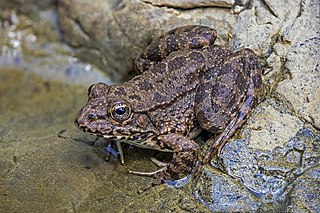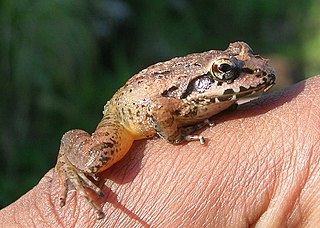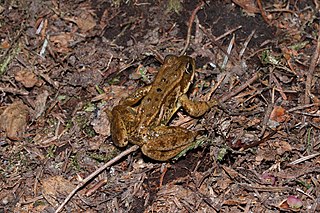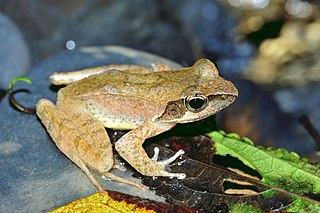
True frogs is the common name for the frog family Ranidae. They have the widest distribution of any frog family. They are abundant throughout most of the world, occurring on all continents except Antarctica. The true frogs are present in North America, northern South America, Europe, Africa, and Asia. The Asian range extends across the East Indies to New Guinea and a single species, the Australian wood frog, has spread into the far north of Australia.

Indosylvirana temporalis, commonly known as the bronzed frog or Günther's golden-backed frog, is a species of true frog found in the riparian evergreen forests of the highlands of southwestern Sri Lanka. They are found abundantly on or close to the ground near water. Individuals are not shy and react by jumping only when provoked. They are important prey of many species of snakes, including the vine snake. Some related species found in the Western Ghats of India were formerly included in this species but were separated in a 2014 study.

Indirana semipalmata is a species of frog endemic to the Western Ghats region of southern India. They are small frogs, reaching lengths of about 36 mm (1.4 in) from snout to vent. The species breeds during the monsoons, laying their eggs on moist rocks and tree bark. Their tadpoles are terrestrial – hatching, feeding, and undergoing metamorphosis without ever entering any standing bodies of water.

Indosylvirana aurantiaca, commonly known as the golden frog, is a species of frog endemic to the Western Ghats of India. The species is also known as the Trivandrum frog, the common wood frog, or the small wood frog.

Amnirana darlingi, commonly known as Darling's golden-backed frog, is a species of frogs in the family Ranidae. It is found in eastern Angola, the Caprivi Strip of Namibia, extreme northern Botswana, extreme southern Democratic Republic of the Congo, Zambia, eastern and northern Zimbabwe, southern Malawi, and west-central Mozambique.

Amolops ricketti is a species of frog in the family Ranidae that is found in southern and eastern China and northern and central montane Vietnam.

The Cascades frog is a species of frog in the family Ranidae found in the Pacific Northwest, mainly in the Cascade Range and Olympic Mountains.
The Chaochiao frog is a species of frog in the family Ranidae, found in China and possibly in Myanmar and Vietnam. Its natural habitats are temperate forests, subtropical or tropical moist montane forests, subtropical or tropical high-altitude shrubland, subtropical or tropical high-altitude grassland, rivers, swamps, freshwater lakes, freshwater marshes, intermittent freshwater marshes, ponds, irrigated land, and canals and ditches. It is not considered threatened by the IUCN.
The Emei music frog is a species of frog in the family Ranidae. It is endemic to China, and is found in central China, in southeastern Sichuan, northeastern Yunnan and western Guizhou provinces. The species name refers to the type locality, Mount Emei in Sichuan, and its vocalizing abilities. The original name Rana musica was replaced with Rana daunchina as the former name was already taken.

The common green frog is a frog species of in the true frog family Ranidae; some sources still use the old name Rana erythraea. It lives in Southeast Asia and is also known as green paddy frog, red-eared frog or leaf frog. The last name, however, commonly refers to the Neotropical tree frogs which make up the subfamily Phyllomedusinae. These are not closely related to H. erythraea, belonging to family Hylidae instead.

Graham's frog – also known as the diskless-fingered odorous frog – is a species of frog in the family Ranidae. It is found in China and Vietnam. Presumably it is also found in Myanmar in areas adjacent to its Chinese distribution area.

Hylarana guentheri is a species of frog in the family Ranidae. It was formerly placed in the genus Rana. It is found in China, Hong Kong, Macau, Taiwan, Vietnam, and possibly Cambodia and Laos. An introduced population is found on Guam. An alternate common name is Günther's Amoy frog, and the honorific is often spelled "Guenther's".

Rana sauteri is a species of true frog endemic to Taiwan. It inhabits low-altitude hill forests and the associated streams. It is an endangered species threatened by habitat loss due to agriculture and infrastructure development. Common names recorded for Rana sauteri include Kanshirei Village frog, Taiwan groove-toed frog, Sauter's brown frog, and Taiwan pseudotorrent frog.

Humerana lateralis is a species of frog in the family Ranidae. It is found in Cambodia, Laos, Myanmar, Thailand, and Vietnam. It is commonly known as Kokarit frog, yellow frog or (ambiguously) wood frog.

Rana longicrus, also known as the Taipa frog or long-legged brown frog, is a species of frog in the family Ranidae. It is distributed to northern and central Taiwan.

Hylarana tytleri is a frog species in the family Ranidae. It is found in eastern and northeastern India, Bangladesh, and southern Nepal, and possibly at lower elevations in Bhutan. It was formerly placed in Rana, and included in the common green frog. It is probably a close relative of that species nonetheless, and thus placed in the revalidated genus Hylarana, of which H. erythraea is the type species. Common name Theobald's ranid frog has been coined for it, although common names for Indian frogs previously identified as Rana erythraea include yellow-striped frog, leaf frog, and leaping frog.

Vaillant's frog is a species of frog in the family Ranidae found in Central America. Its natural habitats are subtropical or tropical dry forests, subtropical or tropical moist lowland forests, subtropical or tropical swamps, rivers, swamps, freshwater lakes, intermittent freshwater lakes, freshwater marshes, intermittent freshwater marshes, rural gardens, heavily degraded former forests, water storage areas, ponds, and canals and ditches.

Hylarana, commonly known as golden-backed frogs, is a genus of true frogs found in tropical Asia. It was formerly considered highly diverse, containing around 84 to 96 valid species, but taxonomic revision resulted in a major change in the contents of the genus, and today it is recognised as containing just four species.

Sylvirana is a genus of true frogs, family Ranidae, found in South and East Asia, from northeastern India in west to China in the north, Taiwan in the east, and Thailand in the south. Originally proposed as a subgenus of Rana in 1992, it has been considered both a full genus and a synonym of Hylarana. Its current recognition at generic level stems from molecular genetic analyses published in 2015.


















